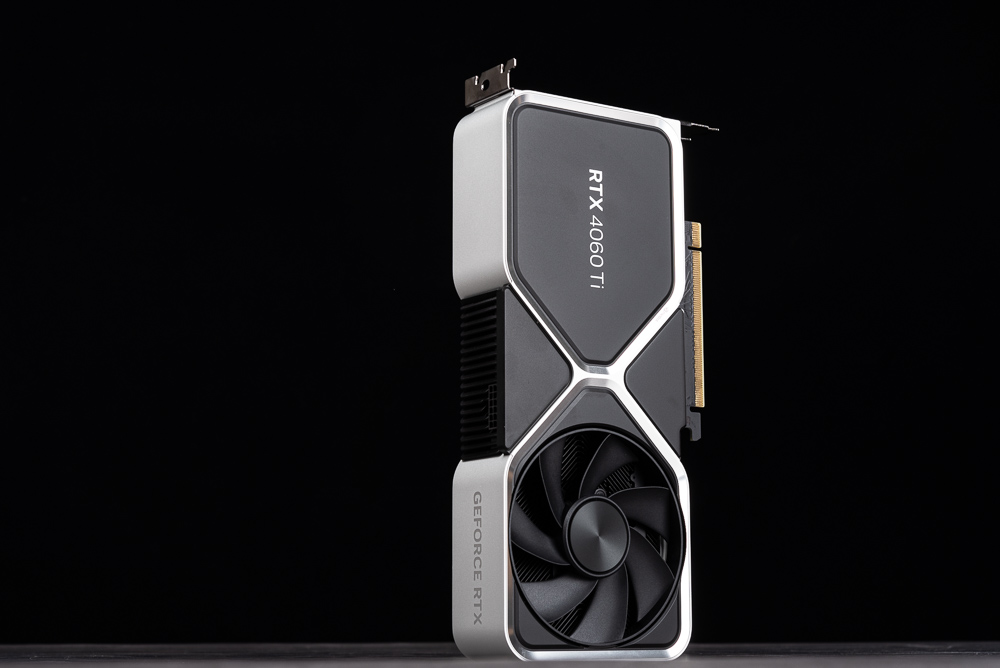
NVIDIA has officially released its latest RTX 4060 series, which is positioned as a high-performance option. Leading the lineup is the NVIDIA GeForce RTX 4060 Ti 8GB graphics card, designed to deliver impressive gaming performance at both 1080p and 2K resolutions. With a TGP (Total Graphics Power) of only 160W, it manages to achieve a 67% performance increase thanks to the upgraded DLSS 3 technology. However, when it comes to general AAA games, the performance improvement is modest at 7%. The pricing for this graphics card is set at $399 in US dollars, and in Taiwan, it starts at $14,690. For gamers, this price point offers excellent value for 2K resolution and serves as a reliable option for FHD gaming. The primary upgrade lies in the AI-driven frame acceleration of DLSS 3, which serves as the core improvement feature for this graphics card.
NVIDIA GeForce RTX 4060 Family: Debut RTX 4060 Ti 8GB / RTX 4060 See you in July
NVIDIA has unveiled its latest mainstream gaming graphics cards, the NVIDIA GeForce RTX 4060 series, just before the start of COMPUTEX. The initial offering is the RTX 4060 Ti 8GB, which carries a price tag of $399 in US dollars and a recommended price of NT$14,690 in Taiwan. This card will officially go on sale tomorrow, on May 24th.
Furthermore, NVIDIA plans to release the RTX 4060 Ti 16GB variant in July, priced at $499 in the US and with a recommended price of NT$17,990 in Taiwan. For those seeking a more budget-friendly option, the RTX 4060 will be available starting from $299.
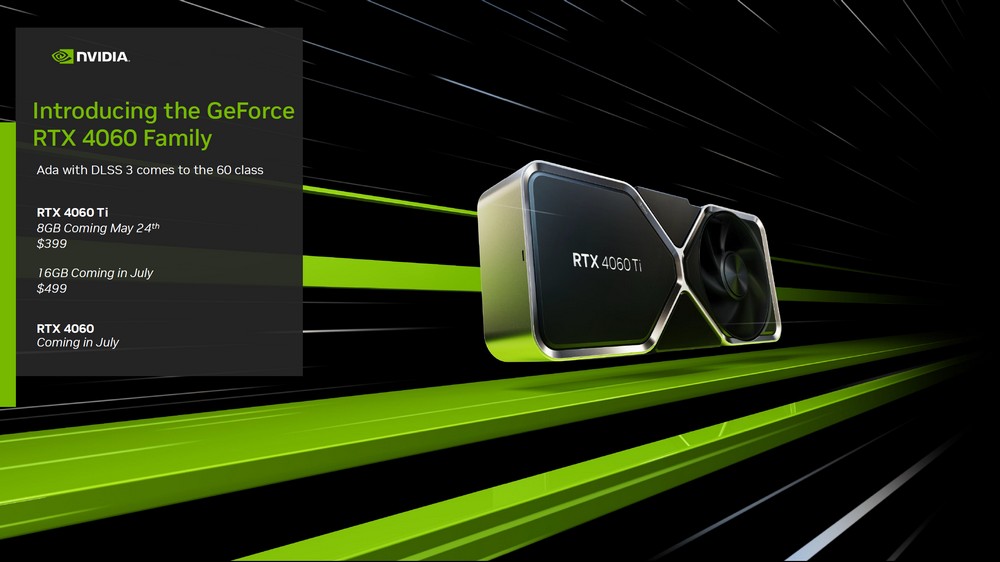
The RTX 4060 Ti 8GB and 16GB variants are equipped with the AD106 GPU, which features 34 sets of SM units, 4352 CUDA cores, 136 Tensor cores, and 34 RT cores. The GPU Boost clock is set at 2535MHz. In terms of memory, both versions come with GDDR6 memory options of 8GB and 16GB. The memory utilizes a 128-bit interface with a speed of 18Gbps, providing a bandwidth of 228GB/s.
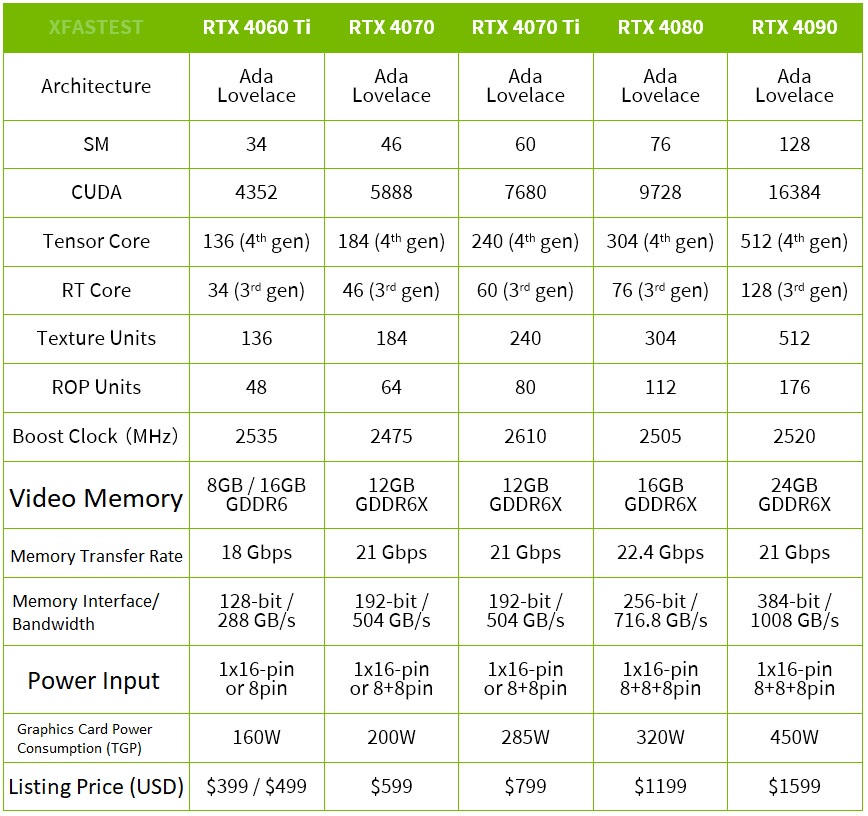
Concerns have been raised among players regarding the potential impact on performance due to the significantly reduced memory bandwidth in the RTX 4060 Ti. In response, NVIDIA has provided an explanation. They state that the Ada core architecture addresses this concern by enhancing the cache hit rate, primarily through the inclusion of a 32MB L2 cache. This helps alleviate the demand for memory bandwidth. As a result, while the RTX 4060 Ti is configured with a memory bandwidth of 288GB/s, taking into account the efficiency of the L2 cache, the effective bandwidth can reach up to 554GB/s.
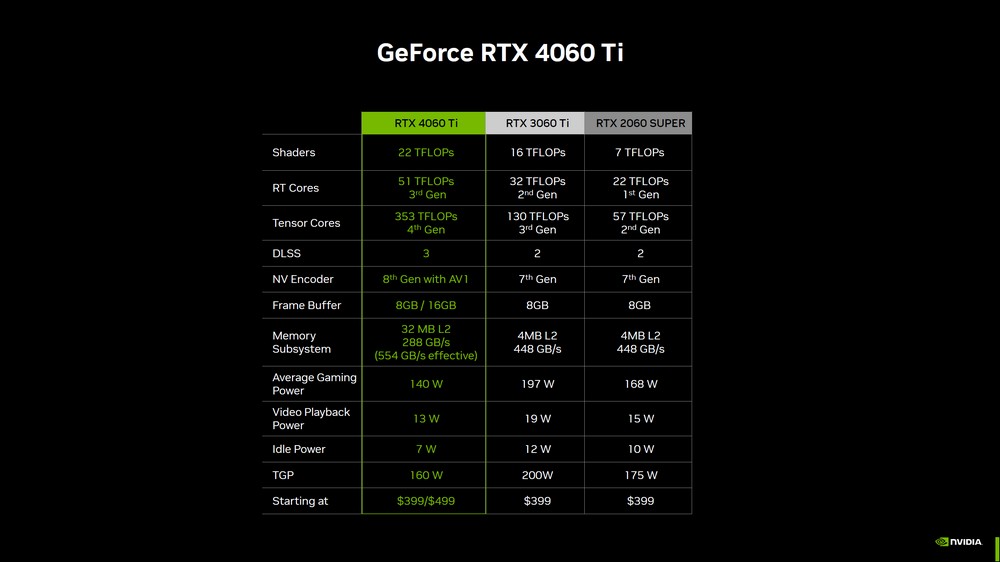
In simpler terms, the memory system of the GPU works in a hierarchical manner. When the GPU core requires data, it first looks for it in the L1 cache, which is the fastest and closest cache. If the data is found in the L1 cache (a cache hit), it can be processed more quickly, improving core utilization. However, if the data is not found in the L1 cache (a cache miss), the GPU needs to access the data from the VRAM, which is why the interface, bandwidth, and capacity of the VRAM are relatively important. This hierarchy allows for faster data retrieval when it is available in the cache, reducing the need to access the slower VRAM.
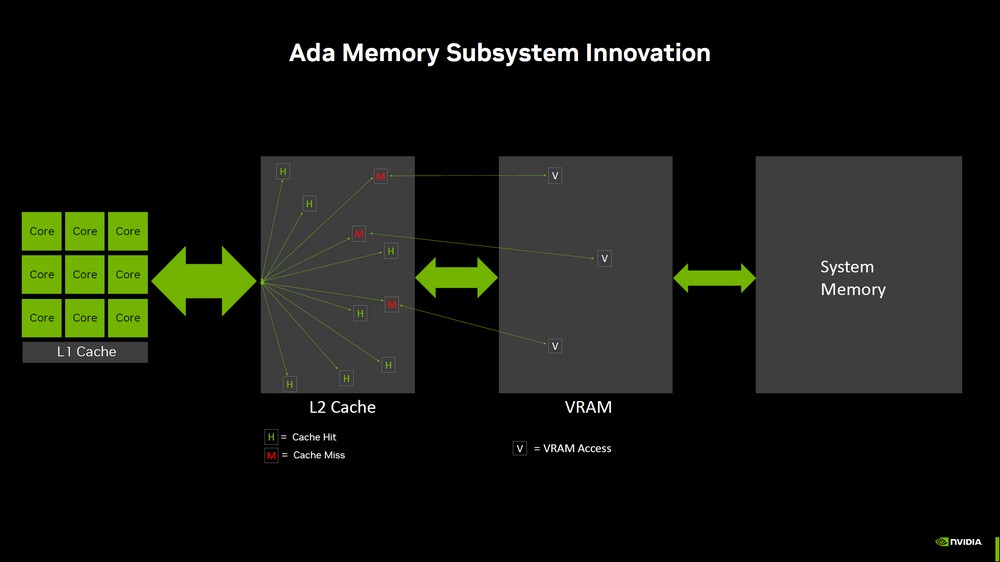
Correct, the increase in L2 cache through the Ada architecture helps improve the overall cache hit rate. This means that the dependence on high VRAM bandwidth is reduced, allowing mainstream and entry-level cards to offer better cost performance. NVIDIA has conducted tests and verified that with a 32MB L2 cache, the VRAM bandwidth requirements for each frame during game calculation and rendering can be reduced. This results in a performance increase of approximately 17%. For ray-tracing games, the performance improvement can reach around 25%, and DLSS 3 games can see a nearly 35% improvement. These advancements demonstrate how optimizing cache utilization can enhance performance without solely relying on increased VRAM bandwidth.
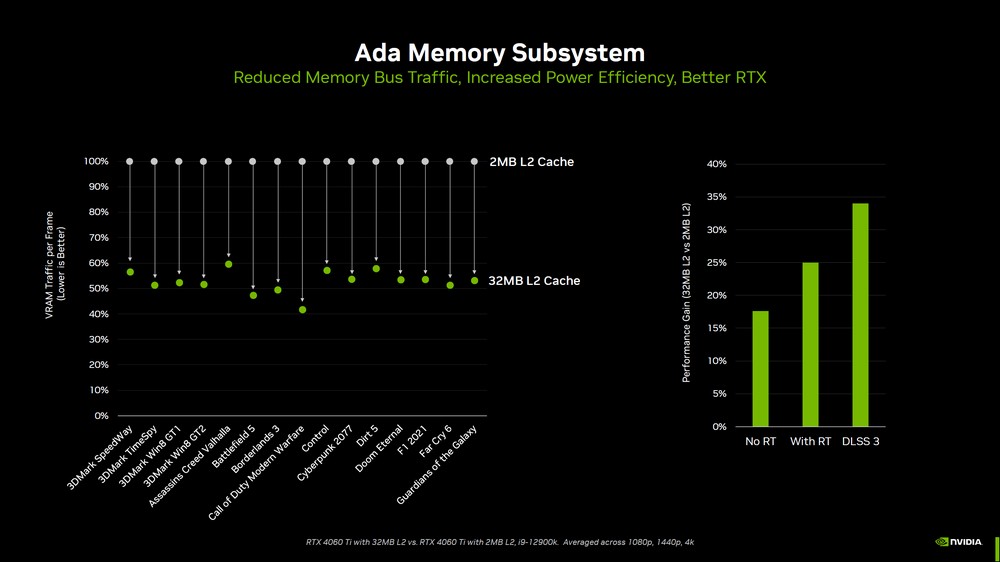
NVIDIA GeForce RTX 4060 Ti 8GB Founder’s Edition Unboxing / Standard 24cm, 2-slot Case Friendly Card
The NVIDIA GeForce RTX 4060 Ti utilizes the same heatsink design as the RTX 4070 Founders Edition, but it features a Space Gray silver finish for the X-Frame metalwork. This graphics card maintains a standard size of 24cm, making it compatible with cases that have a 2-slot installation space. The X-Frame frame, constructed from aluminum alloy, contains cooling fins that facilitate heat dissipation. Inside the frame, there is a vapor chamber responsible for dissipating heat from the GPU and VRAM. Heat pipes guide the waste heat to the cooling fins.
The RTX 4060 Ti is equipped with two 9cm fans to enhance heat dissipation. The rear fan blows air directly onto the fins, expelling hot air from the back of the graphics card. The front fan draws airflow from the front of the case and directs it through the fins and fans towards the top of the graphics card. This design ensures that the case receives a steady flow of cooling airflow, contributing to efficient temperature management.
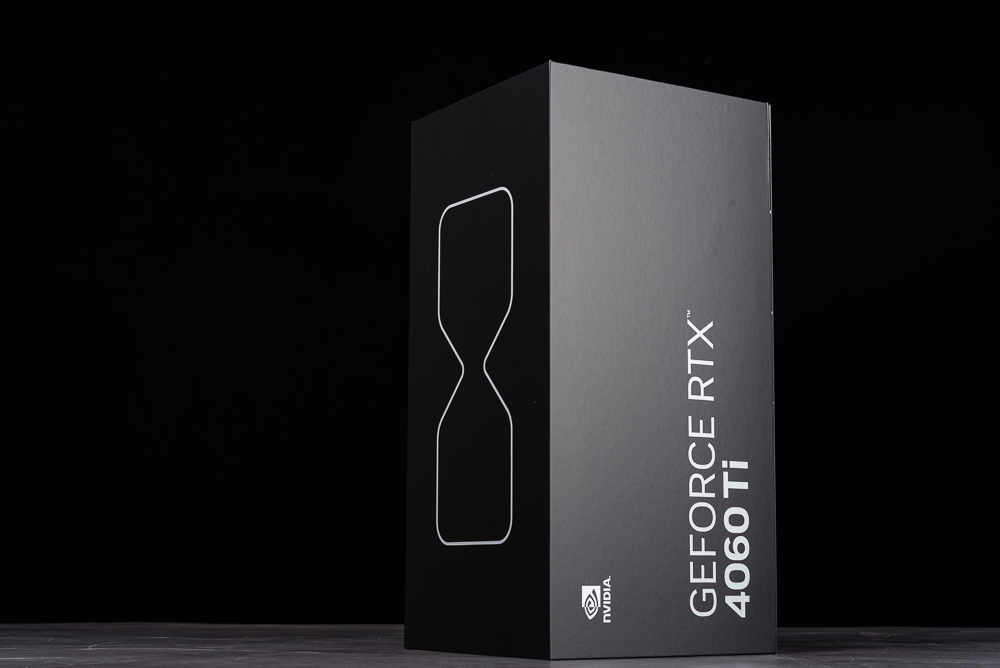
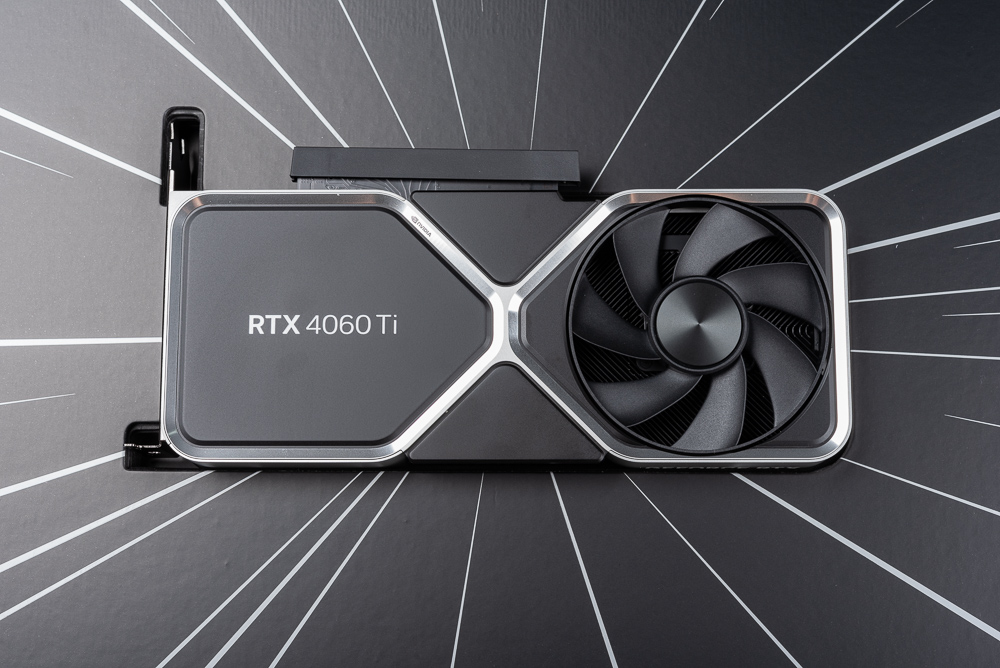
The rear design of the RTX 4060 Ti Founding Edition resembles the front, featuring an X-Frame frame made of space gray aluminum alloy. Previously, the back of the graphics card served as the front, displaying the label “RTX 4060 Ti” and incorporating a front-facing fan for ventilation. Previously, the back of the card was equipped with cooling fins and served as the air intake and heat dissipation area for the rear fan.
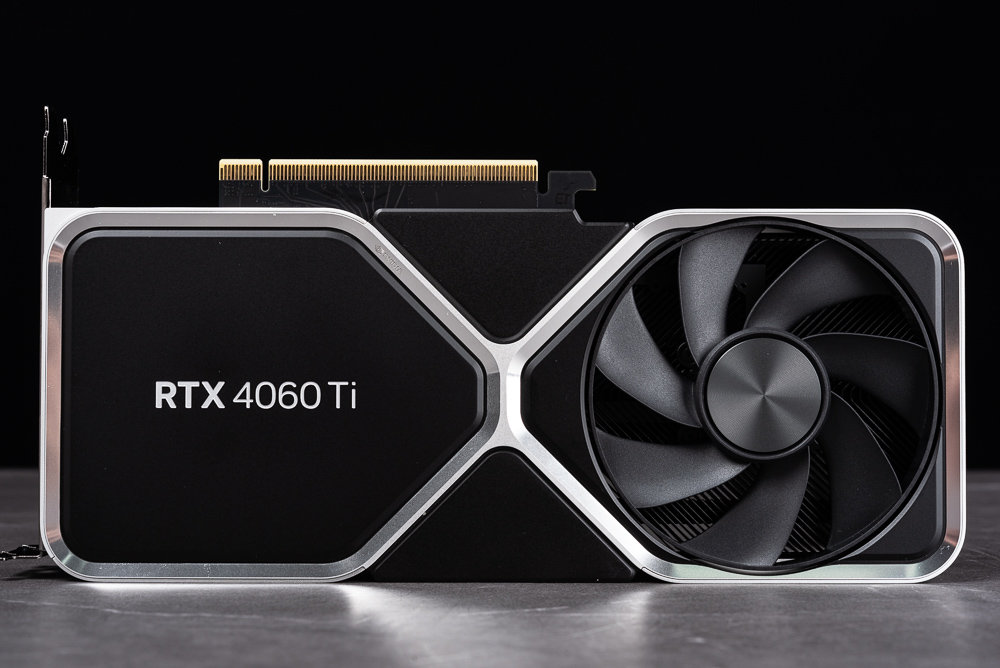
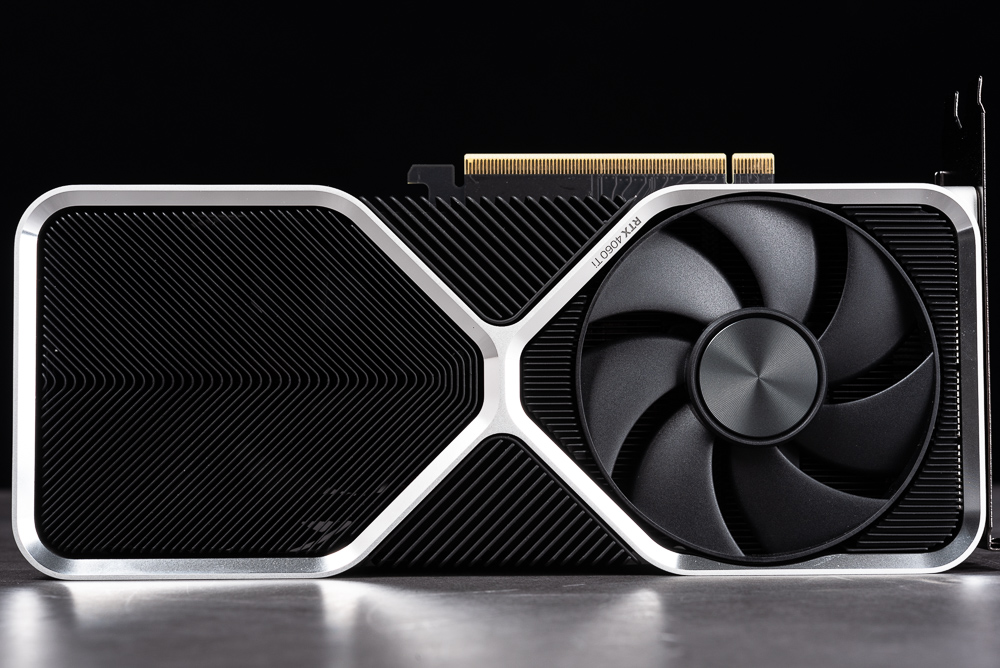
Additionally, located on the side of the graphics card is a PCIe 16 Pin (12VHPWR) power supply socket. However, if it is a graphics card produced by a specific brand, it may also feature the conventional PCIe 6+2 Pin power supply design. The RTX 4060 Ti is bundled with a PCIe 16 Pin to PCIe 8 Pin connector since its Total Graphics Power (TGP) only requires a single power supply of 160W.
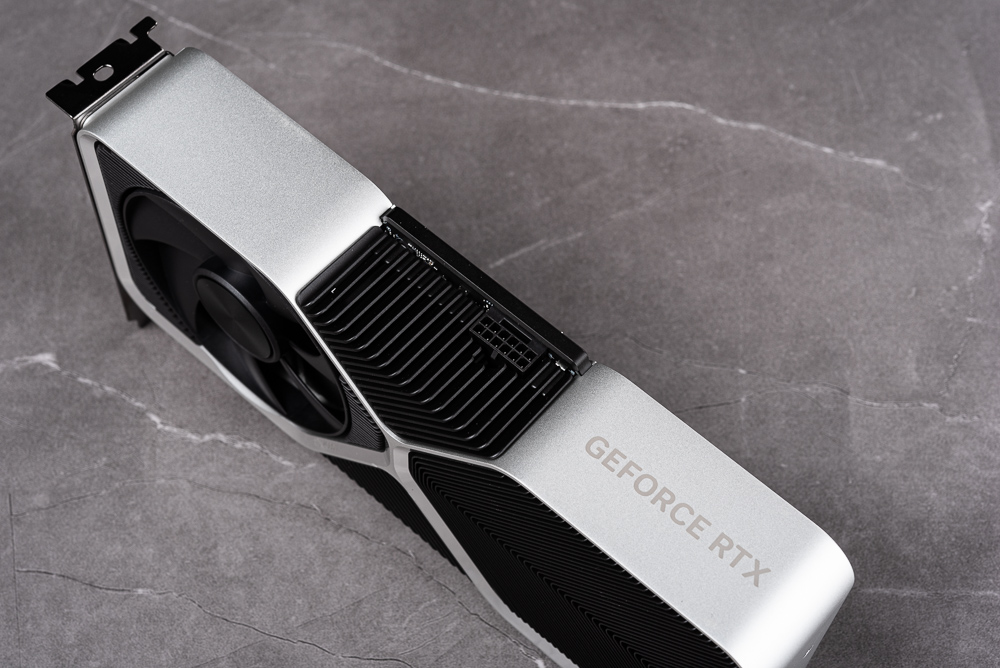

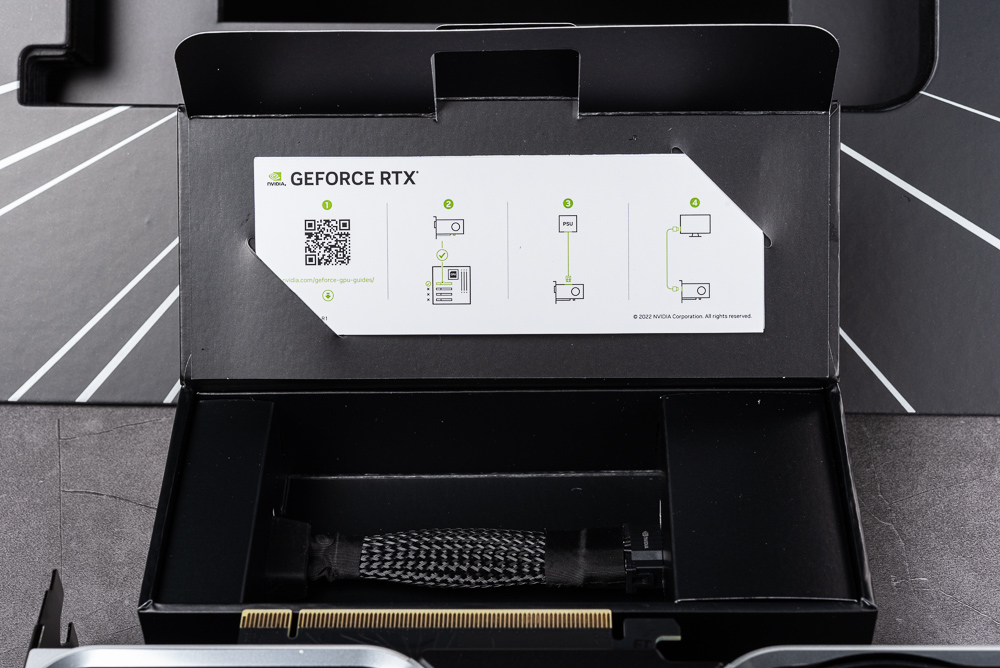
The graphics card’s display output includes HDMI 2.1a, which supports Variable Refresh Rate (VRR) as well as HDR at 4K resolution with a refresh rate of 120Hz or at 8K resolution with a refresh rate of 60Hz. Additionally, it provides three DisplayPort 1.4a ports with Display Stream Compression (DSC) support, offering output capabilities of 12-bit HDR at 4K resolution and a refresh rate of 240Hz, or 12-bit HDR at 8K resolution and a refresh rate of 60Hz. Furthermore, it allows for the simultaneous connection of up to four displays.
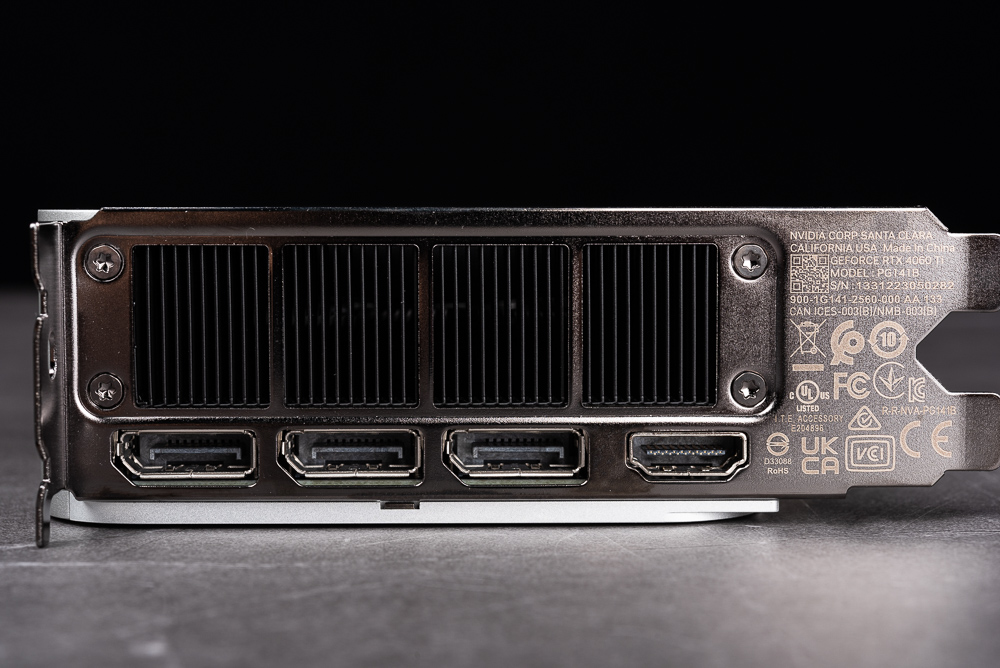
NVIDIA GeForce RTX 4060 Ti 8GB Creation and Rendering Performance Test
The evaluation comprises several tests using DaVinci Resolve 18 and Blender for content creation, as well as gaming tests conducted at both 1440p and 1080p resolutions. The aim is to assess performance in esports titles, AAA games, and games that utilize ray tracing. Additionally, the evaluation includes tests related to DLSS 3 technology. By comparing the performance of both the RTX 4070 and RTX 3060 Ti simultaneously, players will have access to more data for reference purposes.
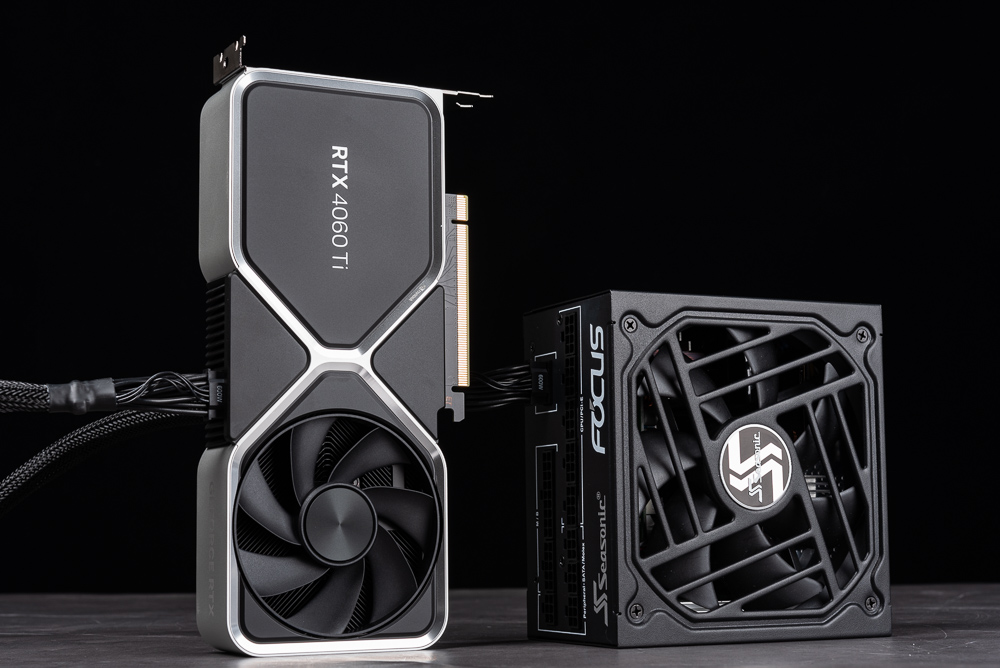
Test Platform
Processor: AMD Ryzen 9 7950X
Motherboard: ASUS ROG CROSSHAIR X670E HERO
Memory: G.SKILL DDR5-6000 16GBx2
Display Card: NVIDIA GeForce RTX 4070, 4060 Ti 8GB, 3060 Ti Founder Edition
System Disk: Solidigm P44 Pro 1TB PCIe 4.0 SSD
radiator: NZXT 360mm liquid cooling
Power supply: Seasonic FOCUS GX (ATX3.0) 850W
Operating system: Windows 11 Pro 21H2 64bit, Resizable BAR On
Driver version: NVIDIA 531.93
GPU-Z has been unable to verify the details of the NVIDIA GeForce RTX 4060 Ti. This graphics processing unit, known as AD106, is manufactured using a 4nm process. It is equipped with 4352 rendering CUDA cores and has 8192 MB of GDDR6 memory (Hynix). The GPU operates at a default clock speed of 2310 MHz, which can be boosted up to 2535 MHz.
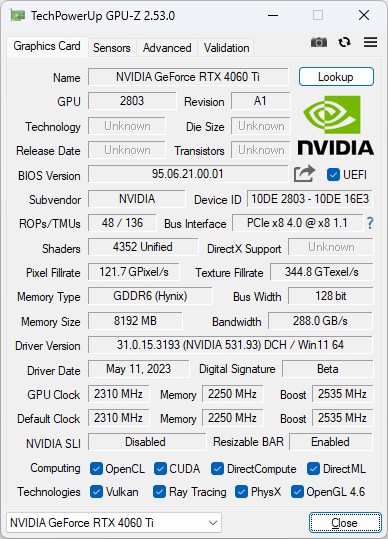
DaVinci Resolve 18 is a video editing software that relies heavily on GPU acceleration. It offers robust features for color correction and special effects, leveraging CUDA core computing for efficient processing. As a result, the software delivers excellent performance for video clip playback and output.
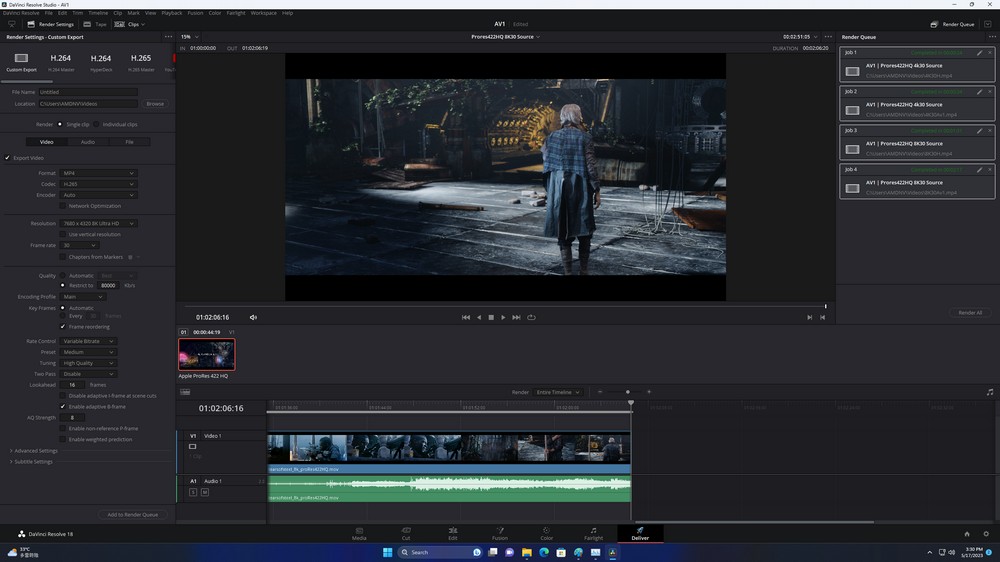
The initial test project involves working with 4K Blackmagic RAW images and a timeline called “Wedding_Heavy_Styles.” This video incorporates various Resolve effects, including OFX effects such as Light Rays, Glow, Sketch, and more, resulting in a highly stylized video.
The “Bride_FaceRefine_Selective_Color” section utilizes Face Refinement for face tracking and emphasizes the main bride with color enhancements. Both 50% Retime and Optical Flow Enhanced Better are employed, utilizing Optical Flow technology to reduce the image speed by 50%.
The “SuperScale2x 4K Source” segment takes a 4K ProRES source video and produces a 2x zoomed-in 4K video output of the subject. On the other hand, “SuperScale4x HD_Source” takes an HD H.264 source video and utilizes Resolve Super Scale to generate a 4K video output.
Due to the lack of optimization for the RTX 4060 Ti in the current official version of the software, some sections may experience slower output times compared to the RTX 3060 Ti. It will be necessary to wait for a software update following the official launch of the graphics card to optimize its performance.
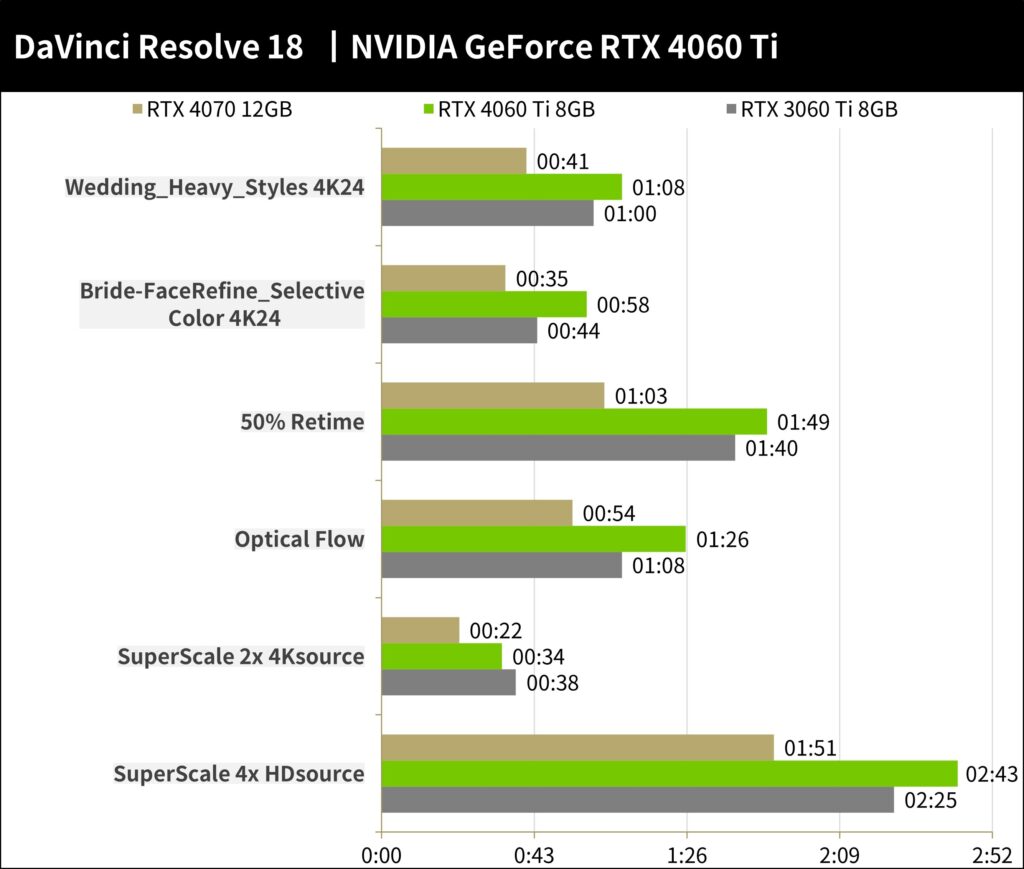
The second test focuses on AV1 and HEVC encoding using dual NVENC encoding. The test project involves a 44-second short film from the Blender Open Movie Project called “Tears of Steel.” It includes 8K Prores442HQ 30FPS and 4K Prores422HQ 30FPS videos to evaluate the performance of HEVC and AV1 encoding.
The output settings primarily utilize the NVIDIA Encoder with the following configurations: Quality restricted to 80000 Kb/s, Encoding Profile set to Main, Rate Control set to Constant Bitrate, Preset set to Faster, Tuning set to High Quality, and Two Pass disabled, among other output settings.
In terms of performance, the RTX 4060 Ti demonstrates similar capabilities to the RTX 4070 when outputting in 4K. However, when it comes to 8K output, the difference in graphics card performance becomes noticeable. For creative work, it is advisable to choose a graphics card that surpasses the RTX 4070 Ti level.
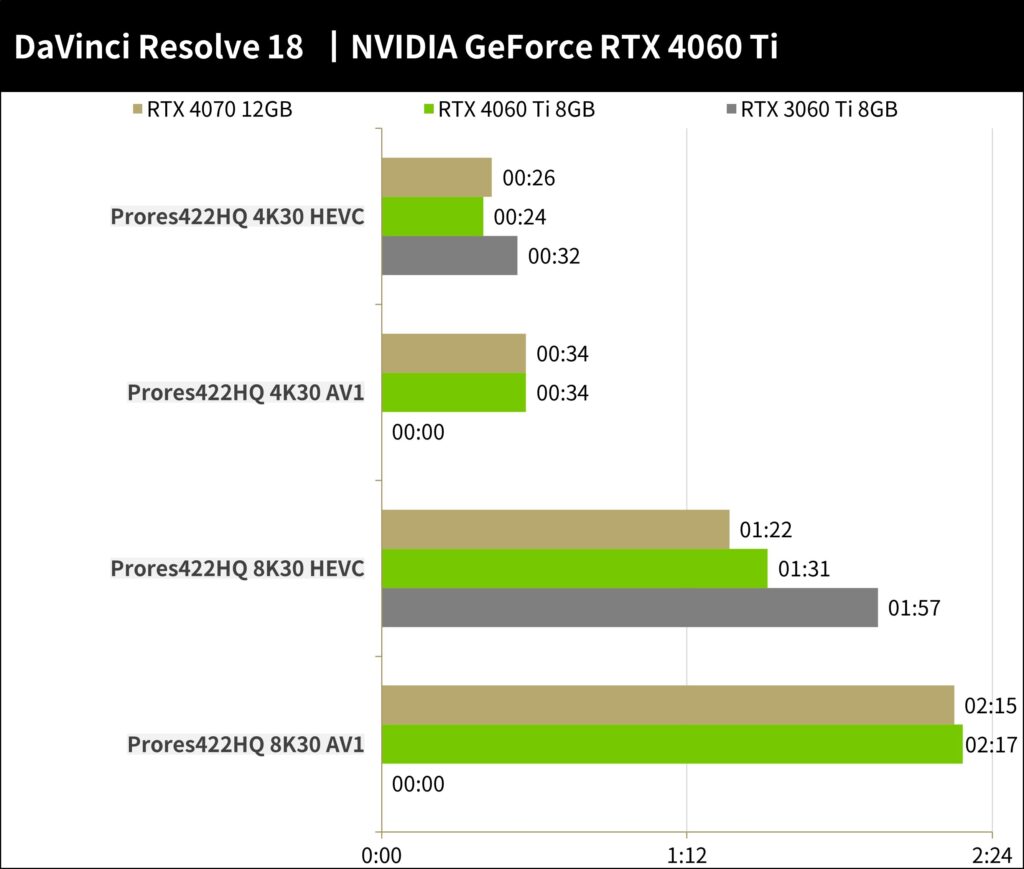
Blender is a versatile, open-source 3D creation tool that is compatible with multiple operating systems. It offers a wide range of 3D operations, including modeling, rigging, animation, simulation, rendering, compositing, and motion tracking, among others. To assess its rendering capabilities, the Blender Benchmark 3.3.0 is utilized to test the rendering performance of the Demo project.
Based on the results obtained from the Blender Benchmark 3.4.0 test, the RTX 4060 Ti demonstrates a 28% increase in computational performance compared to the RTX 3060 Ti. However, there is a decrease of 27% in computational performance when comparing the RTX 4060 Ti to the RTX 4070.
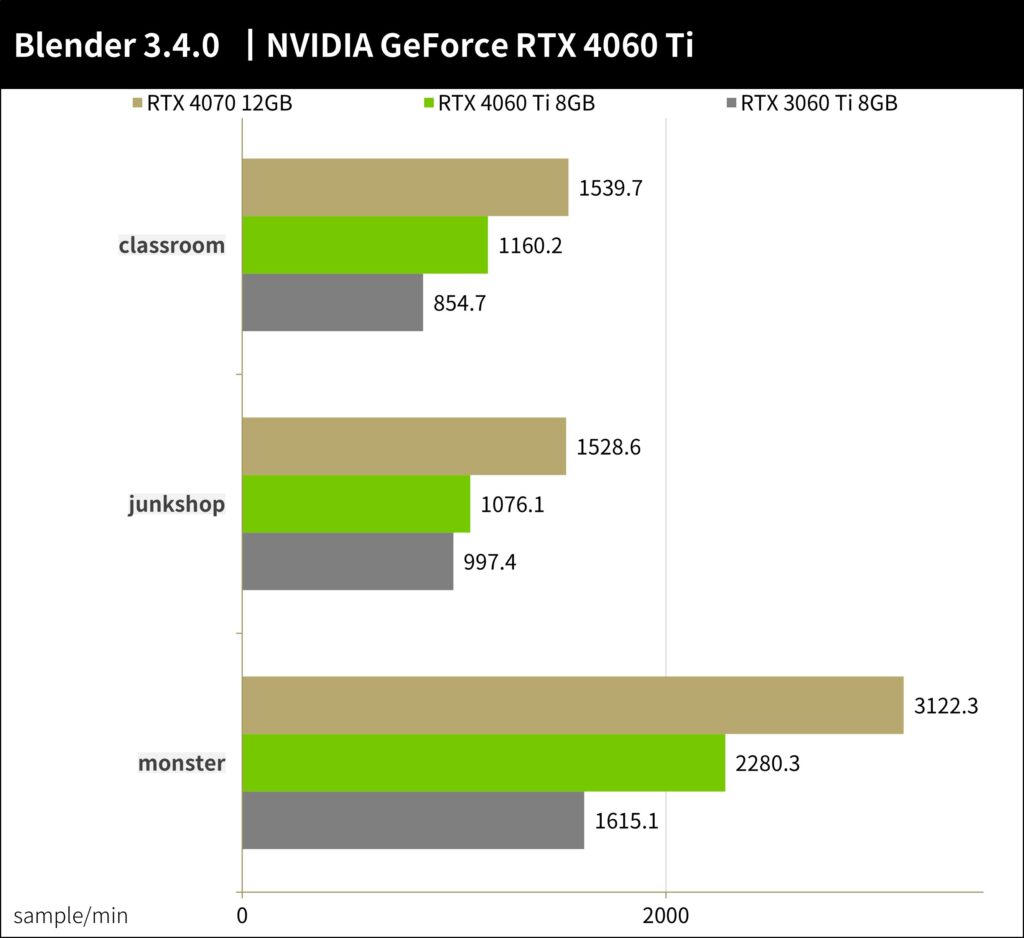
V-Ray Benchmark is developed by Chaos Group. V-Ray is a ray rendering software designed based on the laws of physics, and this tool can perform calculation tests on ray-traced rendered images for CPU and GPU respectively.
According to the V-Ray test, the RTX 4060 Ti has a 13% performance improvement compared to the RTX 3060 Ti, and a -26% reduction in computing performance compared to the RTX 4070.
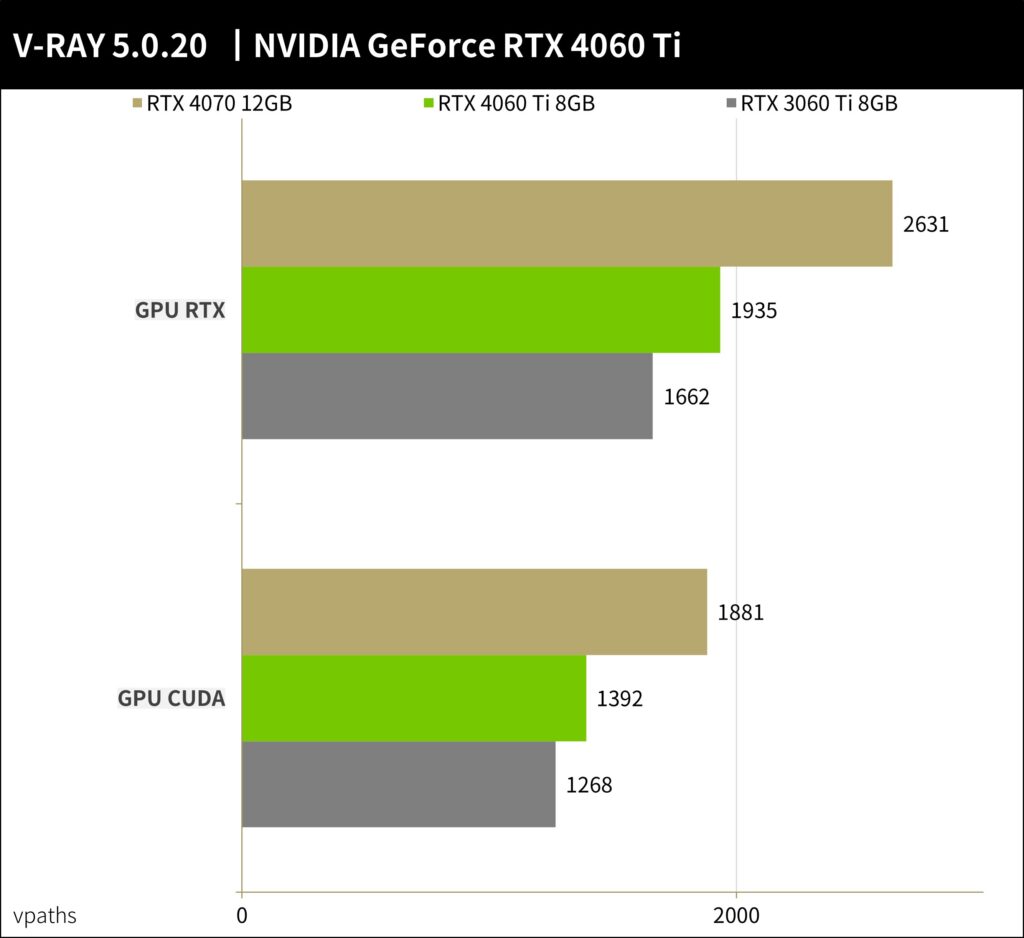
NVIDIA GeForce RTX 4060 Ti 8GB AI image calculation Stable Diffusion test
Stable Diffusion is a highly popular AI deep learning model used for text-to-image generation. After a manual installation, the version released on the Automatic1111 Web UI incorporates the latest cuDNN DLLs (Dynamic-Link Libraries) to optimize GPU acceleration performance. This enables Stable Diffusion to leverage the maximum potential of GPU acceleration and allows for a comparison of the AI computing capabilities among different GPUs.
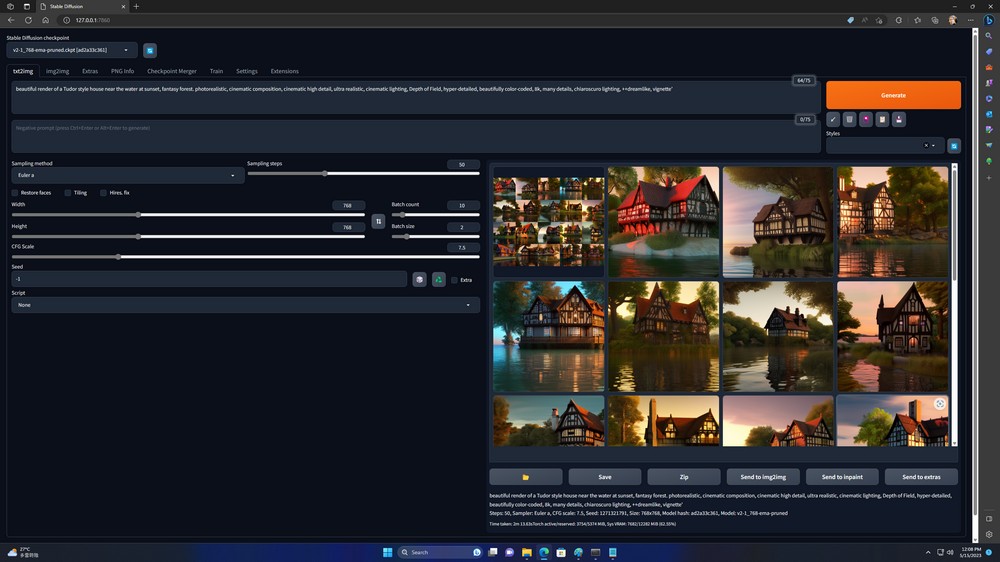
Based on the test settings and specifications described below the image, the RTX 4060 Ti achieves a picture generation speed of 6.25 pictures per minute using Stable Diffusion. This performance demonstrates an 11% improvement compared to the RTX 3060 Ti. However, when compared to the RTX 4070, there is a difference of -31% in terms of effectiveness or efficiency gap.
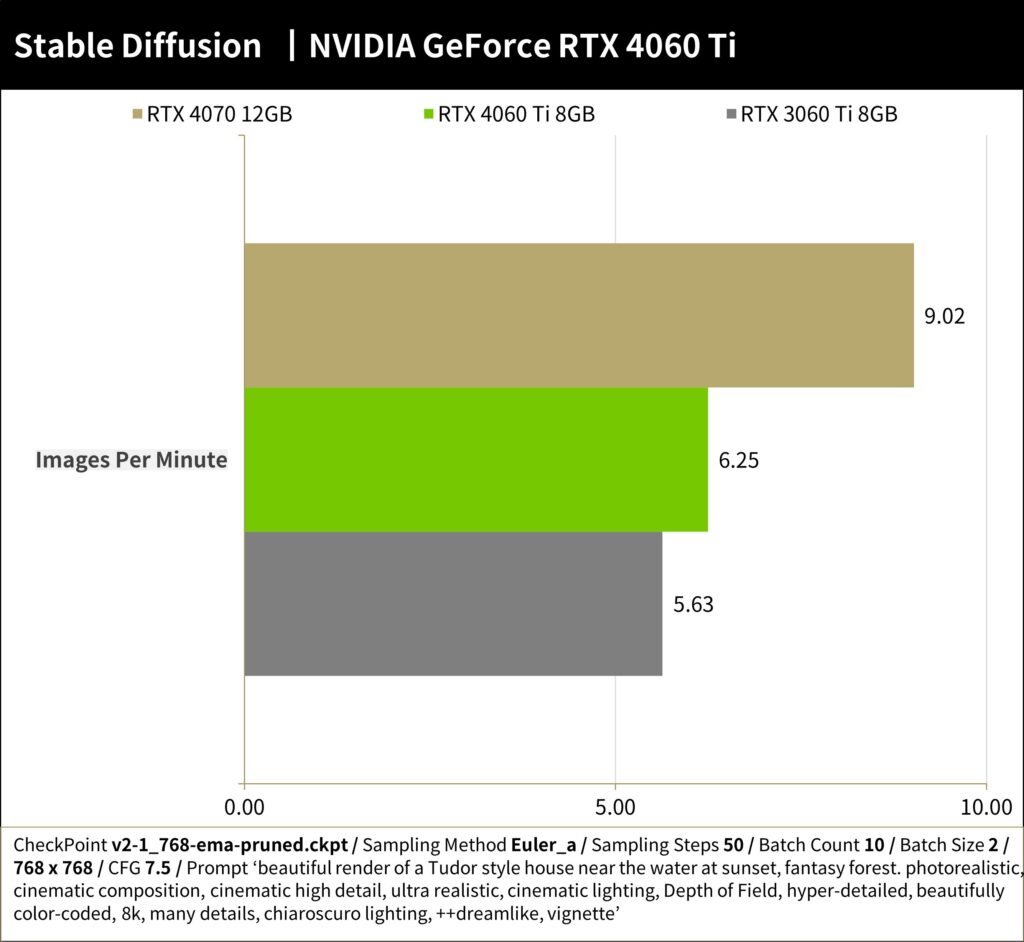
NVIDIA GeForce RTX 4060 Ti 8GB – 3DMark Benchmark Performance Test
The 3DMark Fire Strike performance test is a widely recognized benchmark for evaluating DirectX 11 API performance in various scenarios, including 1080p, Extreme 1440p, and Ultra 2160p resolutions.
In the Fire Strike graphics test, the RTX 4060 Ti achieved 34664 points, while in the Extreme test, it scored 16395 points, and in the Ultra test, it scored 7431 points. When comparing these results to the RTX 3060 Ti, the RTX 4060 Ti exhibits an average graphics performance improvement of 6%. However, it falls slightly behind the performance of the RTX 4070 Ti by approximately -26%.
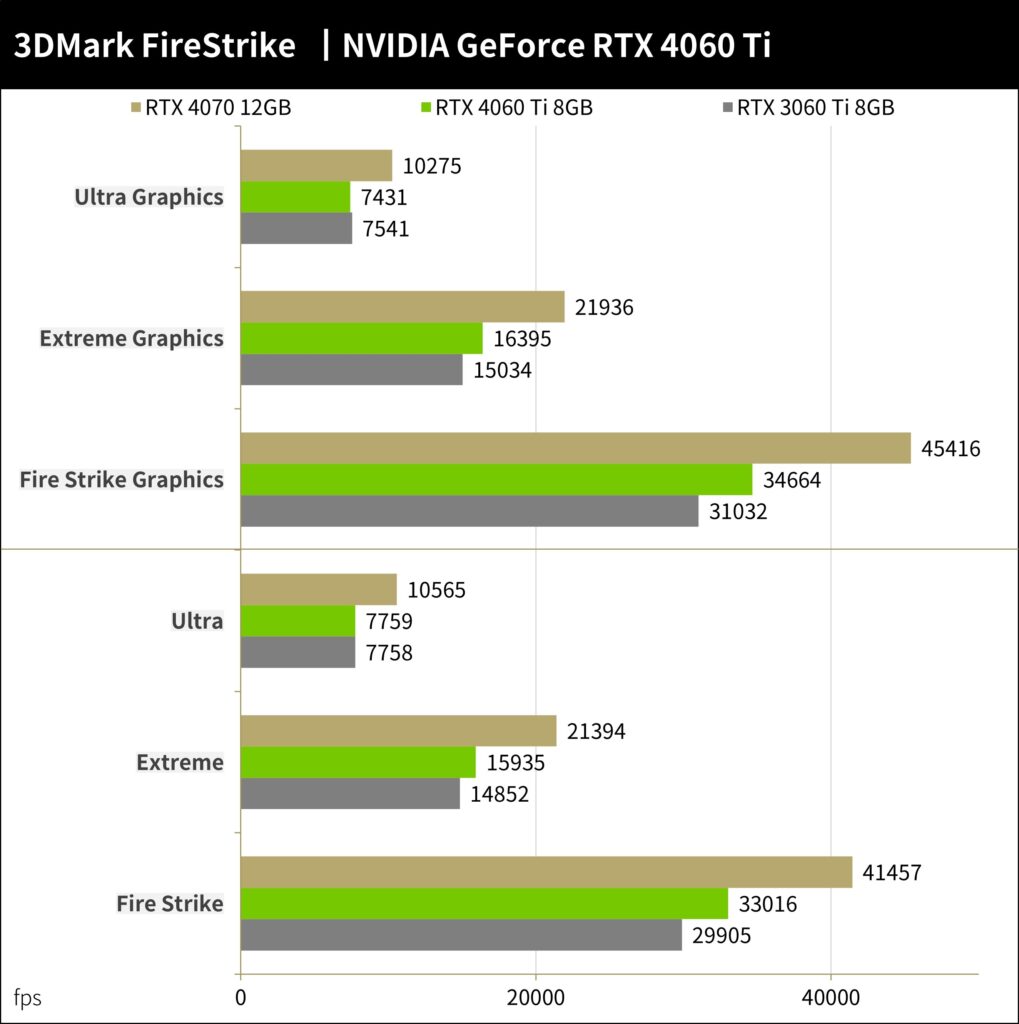
3DMark Time Spy is a benchmark scenario specifically designed to utilize the DirectX 12 API and assess performance at the AAA game level. It evaluates the capabilities of GPUs at 1440p and Extreme 2160p resolutions.
In the Time Spy graphics test, the RTX 4070 scored 13716 points, while in the Extreme test, it obtained 6328 points. Comparing these results to the RTX 3060 Ti, the RTX 4070 demonstrates an 11% performance improvement. However, it falls behind the performance of the RTX 4070 by approximately -26%.
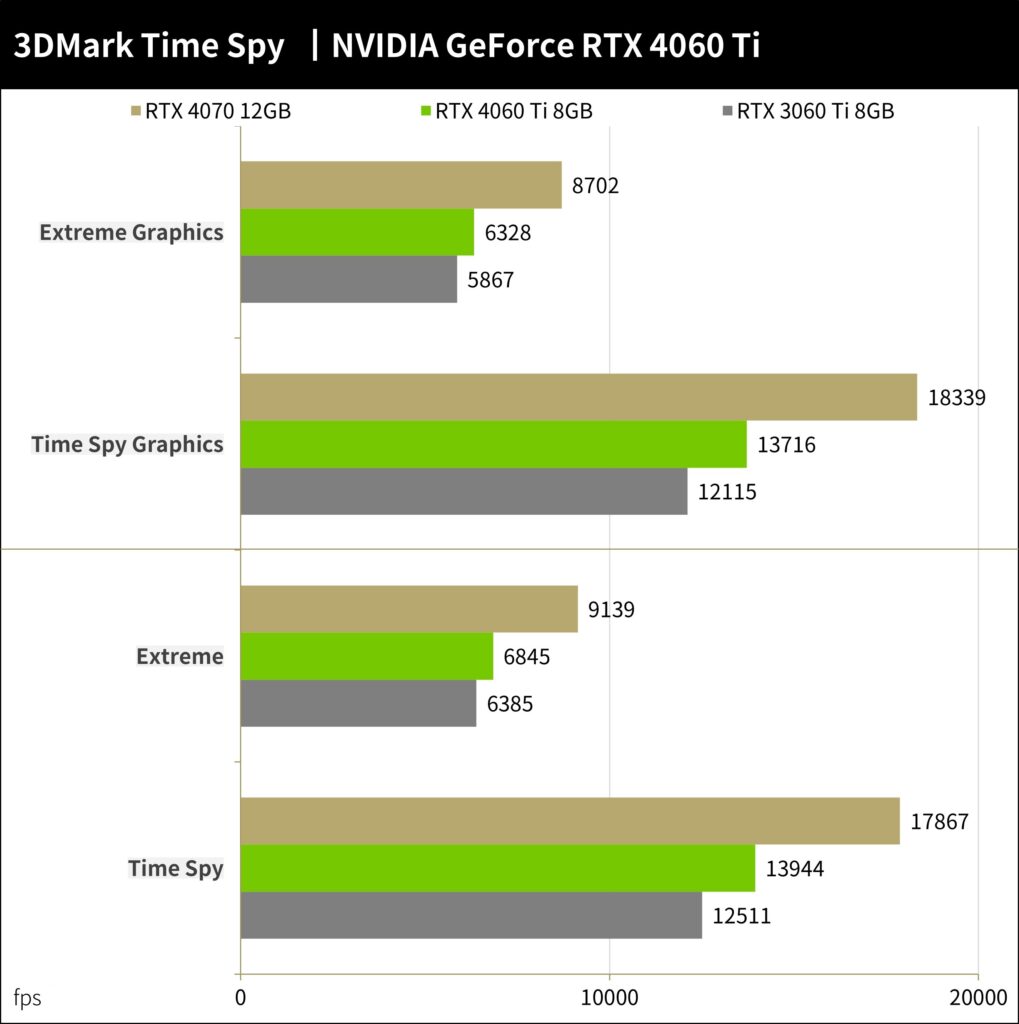
In the ray tracing tests, 3DMark Port Royal incorporates ray tracing functionality into scenes inspired by AAA games, examining the new generation GPU’s ability to accelerate hardware ray tracing. Additionally, the DXR test is a functional test that utilizes the DirectX Raytracing API, while Speed Way is a ray tracing-focused test scenario.
Using the RTX 4060 Ti without DLSS, the results for Port Royal were 37.73 FPS, DXR achieved 38.16 FPS, and Speed Way achieved 32.32 FPS. When comparing these scores to the RTX 3060 Ti, the RTX 4060 Ti demonstrates a 19% improvement in optical tracking performance. However, it falls behind the ray tracing performance of the RTX 4070 by approximately -28%.
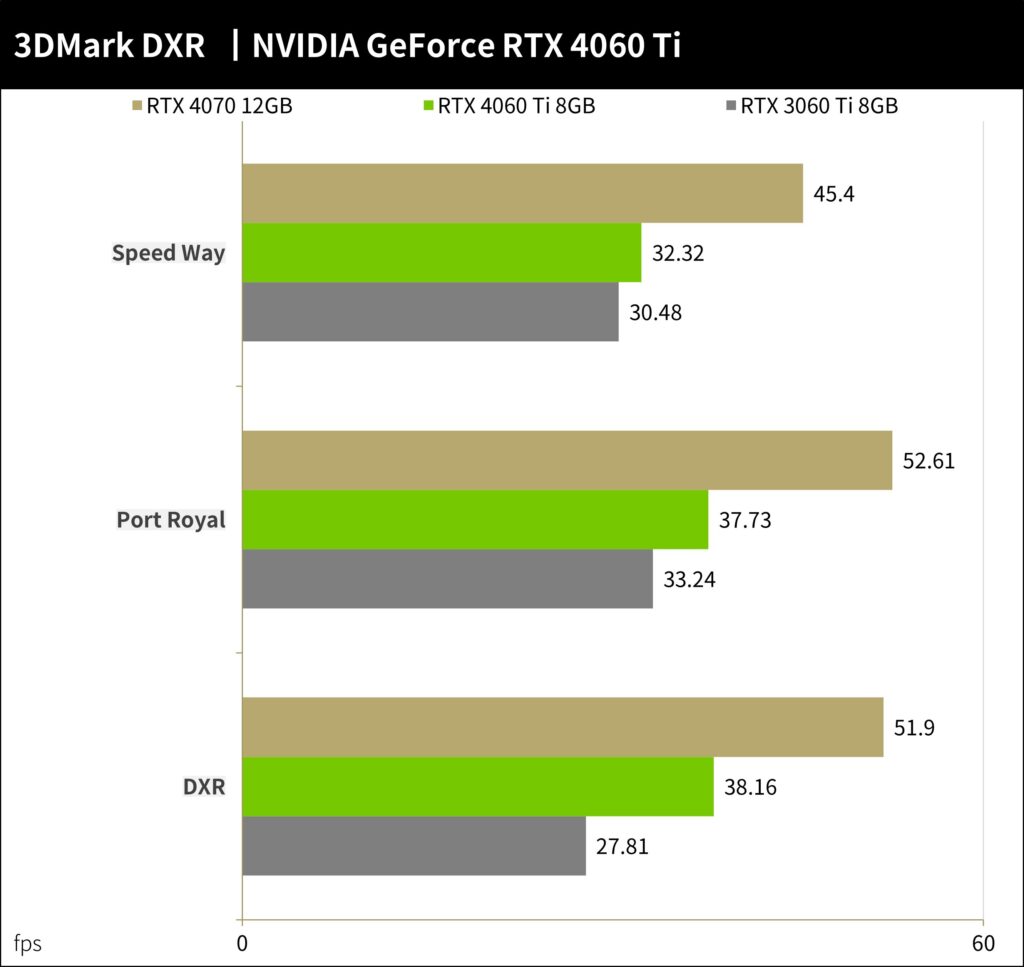
The 3DMark DLSS Feature Test enables performance testing for DLSS 3 and DLSS 2, with settings at 3840 x 2160 resolution and Performance acceleration.
The RTX 4060 Ti achieves approximately 47.05 FPS, showcasing a 2.8x performance improvement when utilizing DLSS 2. Moreover, with DLSS 3, the RTX 4060 Ti achieves about 71.21 FPS, demonstrating a 4.3x performance improvement through the use of AI frame interpolation technology.
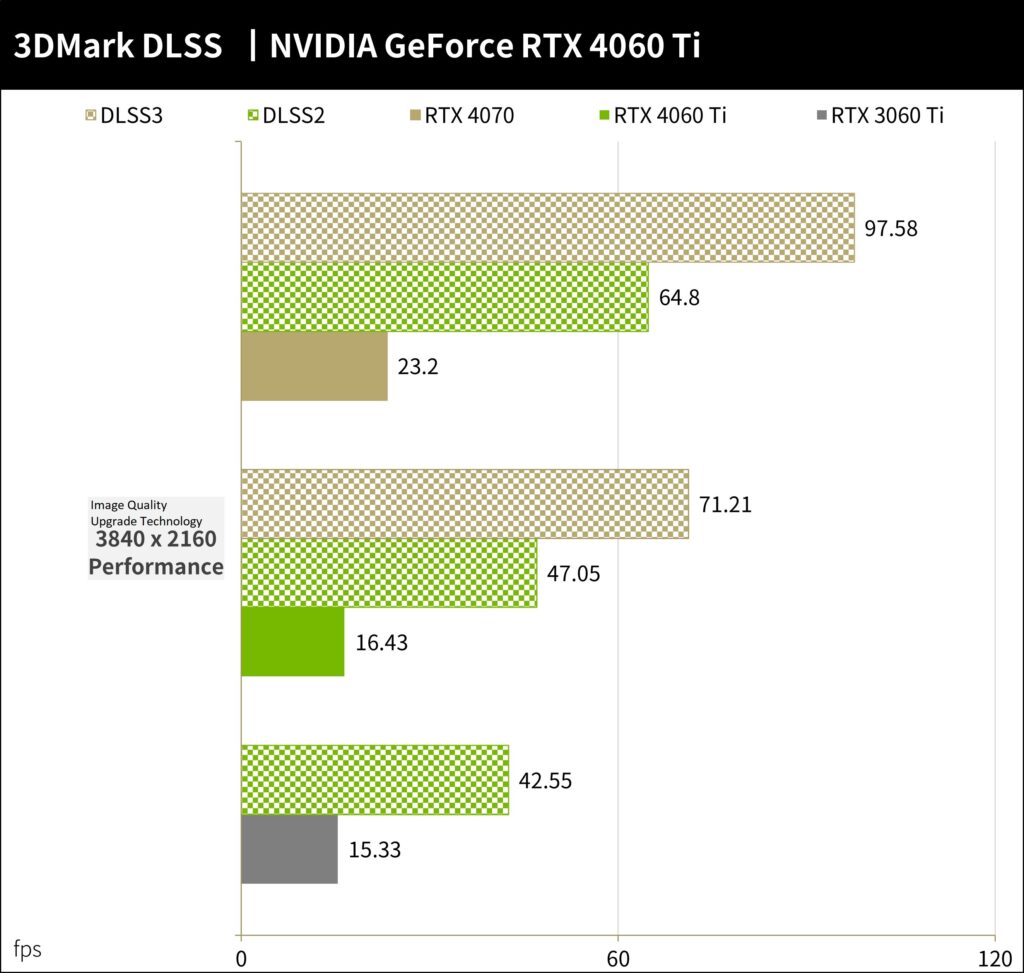
NVIDIA GeForce RTX 4060 Ti 8GB – 4 e-sports games performance test
When it comes to e-sports games such as “Rainbow Six: Siege,” “League of Legends,” “APEX Heroes,” and “CS:GO,” which require high skill levels and involve tactical competitive shooting and DOTA-style gameplay, maintaining a high FPS is crucial, even at higher resolutions like 1440p or 1080p with the highest graphical settings.
In general, the RTX 4060 Ti provides sufficient performance for e-sports games at both 1440p and 1080p resolutions. However, it’s worth noting that in games like “CS:GO” and “League of Legends,” the previous generation RTX 3060 Ti actually performs better. Therefore, if your primary focus is on e-sports games, opting for the previous generation’s cost-effective graphics cards might still be a worthwhile choice.
In terms of performance comparison, at 1440p resolution, the RTX 4060 Ti lags behind the RTX 3060 Ti by approximately -1%, and there’s a performance gap of about -14% compared to the RTX 4070. However, at 1080p resolution, the RTX 4060 Ti enjoys a 5% performance advantage over the RTX 3060 Ti, while still falling behind the RTX 4070 by around -9%.
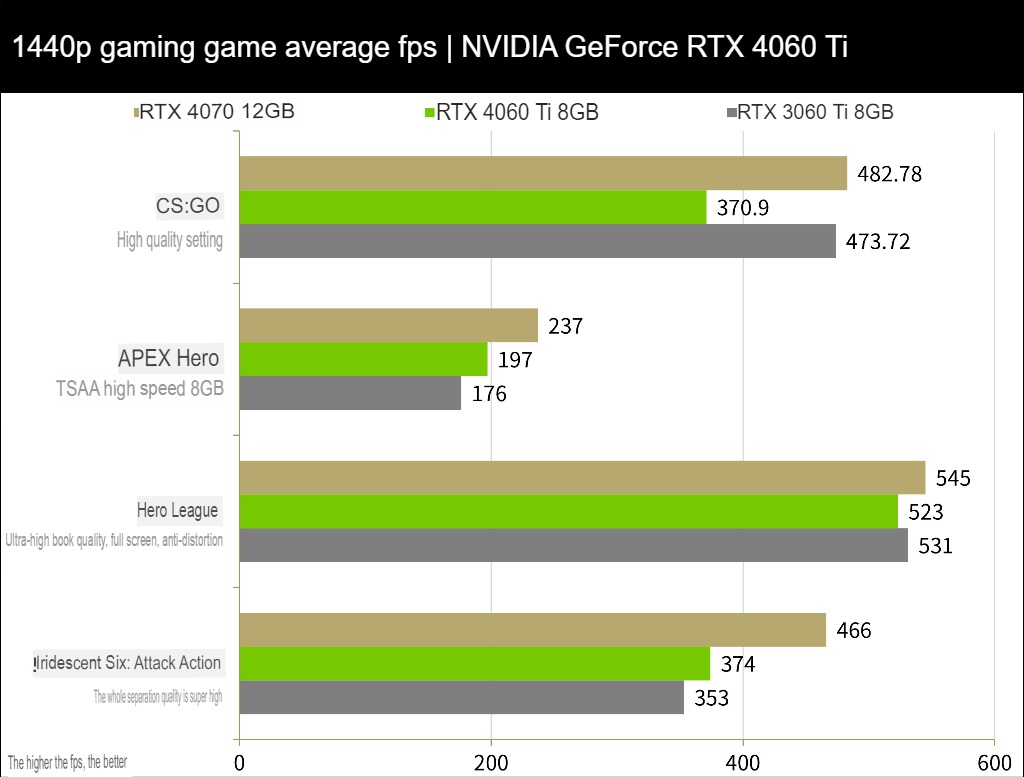
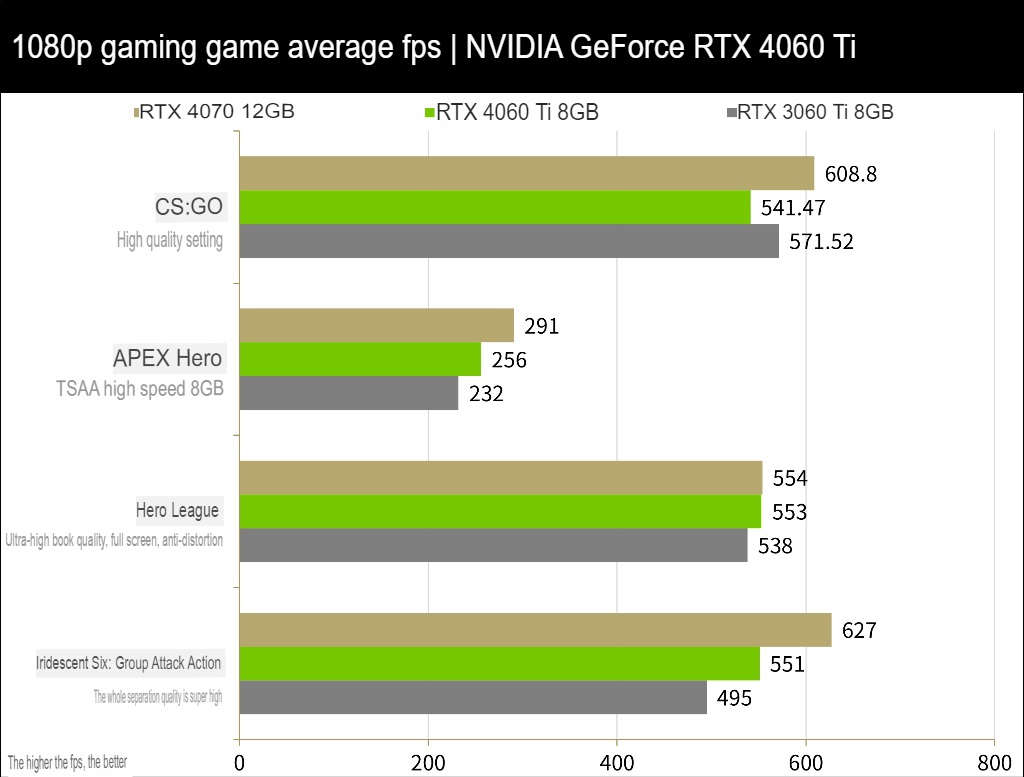
NVIDIA GeForce RTX 4060 Ti 8GB – 10 Games Performance Test
In the average performance test of 10 AAA games at 1440p and 1080p resolutions, with all special effects enabled and no ray tracing or DLSS acceleration, the following games were tested: “F1® 22”, “Tomb Raider: Shadow”, “Death Stranding”, “Gears of War 5”, “The Division 2”, “Horizon: Waiting for Dawn”, “Borderlands 3”, “Assassin’s Creed: Viking Age”, “Red Blood 2”, and “God of War”.
At 1440p resolution, the RTX 4060 Ti achieves an average FPS of 92.45 in these AAA games. This represents a performance upgrade of about 7% compared to the average FPS of 86.55 for the RTX 3060 Ti. However, when comparing it to the average FPS of 124.3 for the RTX 4070, the RTX 4060 Ti shows a performance gap of approximately -26%.
Moving on to 1080p resolution, the RTX 4060 Ti averages 129.31 FPS in these games, resulting in an 11% performance improvement compared to the average FPS of 116.7 for the RTX 3060 Ti. Nevertheless, it falls short of the average FPS of 164.4 achieved by the RTX 4070, exhibiting a game performance difference of about -21%.
NVIDIA GeForce RTX 4060 Ti 8GB – 11 Ray Tracing Game Tests
In the ray tracing DXR game tests, 11 games were evaluated, including “The Witcher 3: Wild Hunt,” “Star Wars Jedi: Survivors,” “Hogwarts: Legacy,” the ray-traced version of “Portal with RTX” by NVIDIA, “Cyberpunk 2077,” “Control,” “Watch Dogs: Legion,” “Spider-Man: Miles Morales,” “Marvel’s Avengers,” “Far Cry 6,” and “Microsoft Flight Simulator” (with DLSS 3 acceleration).
Using the RTX 4060 Ti at 1440p resolution with DLSS 3 acceleration, the average FPS results were as follows: “The Witcher 3: Wild Hunt” achieved 84 FPS, “Portal with RTX” averaged 82 FPS, “Cyberpunk 2077” averaged 89.3 FPS, and the average FPS across all 11 ray-tracing games was 87.1 FPS.
At 1440p resolution, the RTX 4060 Ti exhibits a 43% performance improvement in ray-tracing games compared to the average FPS of 63 for the RTX 3060 Ti, but lags behind the average FPS of 113.7 for the RTX 4070 by approximately -23%.
For 1080p resolution, the RTX 4060 Ti achieves an average FPS of 118.3, which represents a 51% performance improvement over the RTX 3060 Ti’s average FPS of 82.3. However, it falls slightly behind the average FPS of 142.8 for the RTX 4070 by approximately -16%.
NVIDIA GeForce RTX 4060 Ti 8GB power consumption and temperature measurement
The power consumption and temperature tests for the graphics card were conducted using the Time Spy Stress test, Furmark, and “Cyberpunk 2077.” The power consumption was measured using the PACT tool provided by NVIDIA, which monitors the wattage supplied by the PCIe slot and the power supply’s 12V rail.
Regarding graphics card temperature, the RTX 4060 Ti Founder Edition maintains a maximum temperature of 64°C during the stress test. In “Cyberpunk 2077,” the temperature is slightly lower at 58°C. In comparison, the previous generation RTX 3060 Ti reaches a maximum temperature of 72°C. Thanks to the efforts of TSMC’s manufacturing process and NVIDIA’s engineering, the first-generation RTX 40 series demonstrates excellent temperature performance.
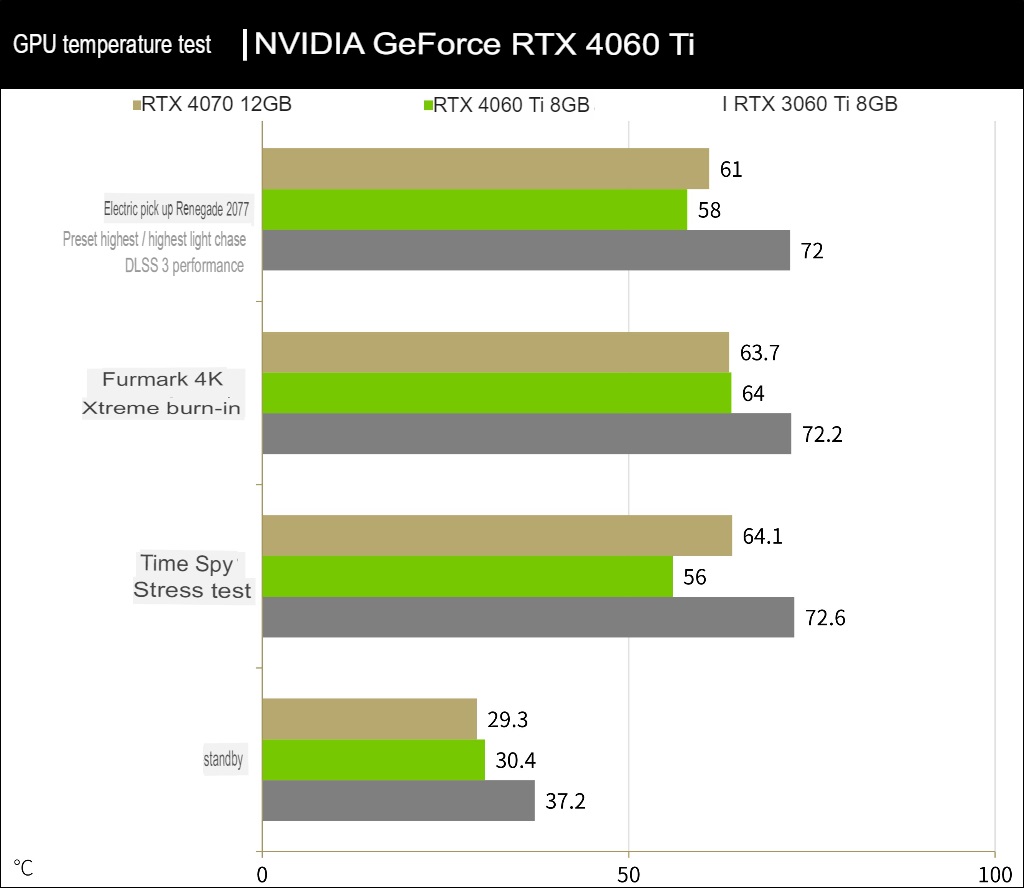
During the TBP (Total Board Power) power consumption test, the RTX 4060 Ti Founder Edition exhibited an average power consumption of 112W in the Time Spy Stress test. In the Furmark 4K Xtreme burn-in test, it reached a maximum power consumption of 154W. However, during gameplay in “Cyberpunk 2077,” the power consumption was measured at 132W.
Comparatively, the power consumption of the RTX 4060 Ti appears to be higher than that of the RTX 3060 Ti, which has a power consumption of 195W. This can be attributed to the advanced TSMC manufacturing process and the inherent power characteristics of NVIDIA’s design. While the RTX 40 series may be relatively more expensive due to these factors, the overall price-performance ratio may not be as favorable as the RTX 30 series.
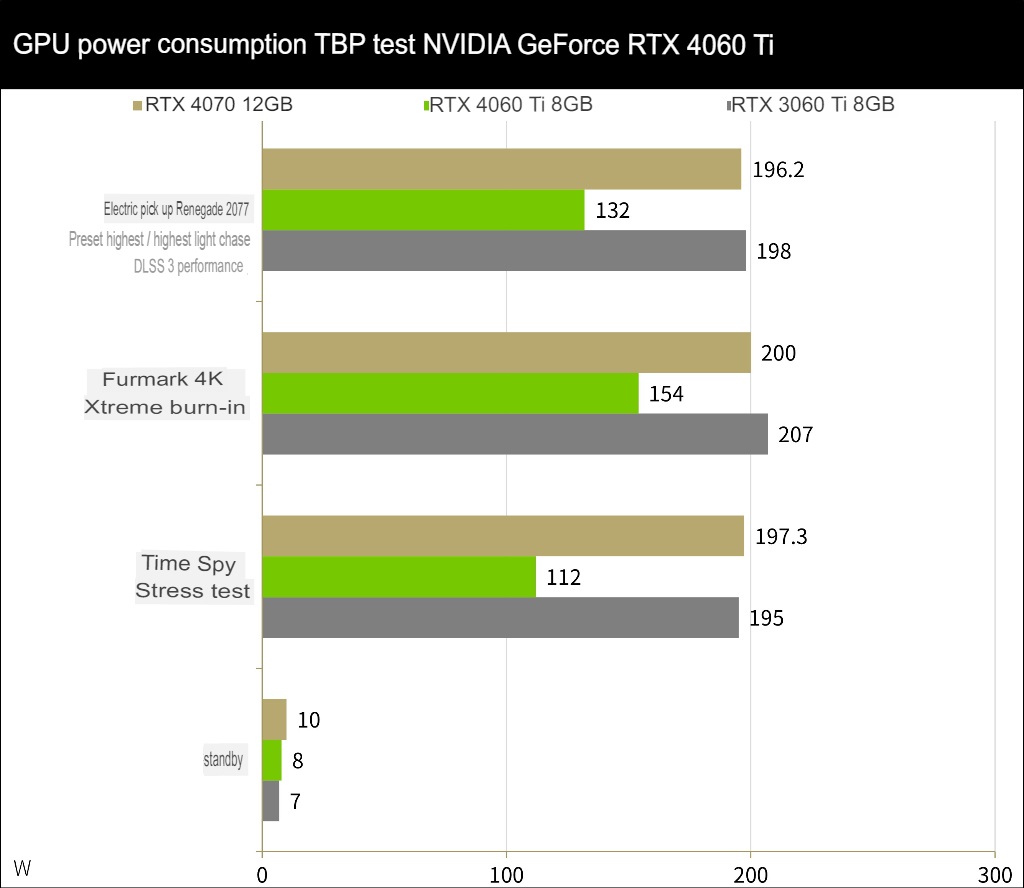
Summarize
The NVIDIA GeForce RTX 4060 Ti offers excellent performance as an entry-level 2K gaming graphics card, capable of handling full special effects at mainstream 1080p resolution. The average FPS achieved in 10 AAA games at 1440p was 92.45, and at 1080p, it reached 129.31. In terms of next-generation DXR ray-tracing games, it averaged 87.1 FPS at 1440p and 118.3 FPS at 1080p.
Given its sufficient performance, one might question why NVIDIA classifies the RTX 4060 Ti as a 1080p gaming graphics card. The answer can be understood by comparing its performance to previous generation cards. In the tested AAA games, the RTX 4060 Ti only shows a modest performance improvement of 7% at 1080p and 11% at 1440p compared to the previous generation RTX 3060 Ti. However, in ray-tracing games with DLSS 3 acceleration, it maintains a significant lead with a 51% performance advantage at 1080p and a 43% advantage at 1440p.
The suggested price of the RTX 4060 Ti in Taiwan starts at $14,690, while the current price of the RTX 3060 Ti is around $12,990, and even the RTX 3070 is priced around $15,990 in the secondary market. This pricing situation makes the RTX 4060 Ti at $399 somewhat awkward. Although its general game performance is close to the RTX 3070, it excels in ray tracing and DLSS-supported games.
In summary, the current price of the RTX 4060 Ti may not offer the best cost-effectiveness relative to its price. However, for those who enjoy next-generation ray-tracing AAA titles or frequently play the latest games, choosing the RTX 4060 Ti with DLSS 3 acceleration can provide better performance than the first-generation RTX cards. The current market situation may present some challenges, as the RTX 4060 Ti is priced as a 2K graphics card but offers a price advantage over FHD cards.
If you primarily play games at 1080p, it is recommended to wait until July to assess the performance of the RTX 4060 before making a purchasing decision.
If this article is helpful for you, please share this article with your friends on social media. Thank you!
This article is based on the personality of the reviews. You are responsible for fact-checking if the contents are not facts or accurate.
Title: $399 Price, Free DLSS3! NVIDIA GeForce RTX 4060 Ti 8GB Test Report: 2K and FHD Pricing